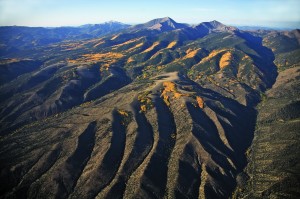by John Orr
Forecasting water year 2011
November 1 is the usual start of the water year here in Colorado, although some – including the the U.S. Army Corps of Engineers – say it starts on October 1. That said, by the time December rolls around the new water year has started, irrigation is mostly off, except for livestock and some farmers that like to ice their meadows heading into the winter.
During the early part of the water year, irrigators and water supply folks all keep one eye on the sky hoping for good snowpack so that the runoff will be sufficient to fill reservoirs and keep streamflow high enough for the late summer direct irrigators. The same groups like to try to guess at the forecast for the season as well. That’s the situation across the state right now. Will the snow come, will it be average or above, and will it all run downstream before users need it?
There are an array of online tools for weather watchers to use for forecasting.
Many still use the Farmers Almanac. Their online map for this winter shows Colorado bisected roughly northeast to southwest by “Very Cold and Snowy” and “Colder and Wetter Than Normal” predictions.
Each year in January, the National Resource Conservation Service (NRCS) publishes their first basin outlook report for the year. These are updated monthly through June and show the probabilities for streamflow based on snowpack. They also include a summary of pertinent data by basin.
The NRCS also operates remote (snotel) weather stations to collect weather data. The reports they compile are available at www.co.nrcs.usda.gov/snow/snow/snow_all.html. Of interest to many are the individual snotel sites at www.wcc.nrcs.usda.gov/snotel/Colorado/colorado.html.
For example, as I am writing this article, the snotel site at St. Elmo is reading seven inches of snow and 1.4 inches of snow water equivalent (SWE) (the precipitation equivalent when the snow melts). Up at Fremont Pass, compare the snotel reports of a snow depth of 19 inches and 3.7 inches of SWE. There can be a lot of variability in measurements due to location and elevation, as you would expect.
The National Oceanic and Atmospheric Administration website (www.noaa.gov) contains many forecasting tools for your browsing pleasure.
You can get their updated local five-day forecast for your town by entering your zip code. They issue long-range forecasts as well. The 90 day forecast issued in September explained that La Niña was setting up in the Pacific Ocean and would impact weather throughout the winter.
With La Niña we often see drying in the southern tier of states in the U.S. and wet weather in the Northwest. Colorado sits in the middle of the two zones, so predicting La Niña’s influence on our snowpack is iffy.
At a meeting organized by the Colorado Water Conservation Board in October – called to discuss the potential of drought in 2011 – the NOAA’s Klaus Wolter said, “La Niña is on a steamroller.” Wolter – an El Niño/La Niña expert – added, “[Colorado has] never really had a dry winter with La Niña.” He noted that we often have a dry spring in La Niña years.
So, what will water year 2011 be like?
The best guesses right now are for an average snowpack year for the state overall with the possibility of a drier spring that could impact snowpack by reducing totals and/or leading to an earlier runoff. The expected dry conditions in the southwest could lead to more dust on snow events and the resulting earlier runoff in the south and central mountains.
Water reservoirs around the state are in great shape going into the new water year. For example, Blue Mesa Reservoir is at 66.8% of capacity and 95.2% of average storage as of November 16. Most Front Range water suppliers’ reservoirs are close to full, which should mitigate the impact of stage one drought conditions in eastern Colorado. Check out the U.S. Drought Monitor website at www.drought.unl.edu/dm/monitor.html.
If dry conditions do show up in the spring, water suppliers may not be able to fill reservoirs with spring runoff.
Chaffee County geothermal lease
On November 10 the Bureau of Land Management issued the first ever geothermal lease in Colorado. 3E Geothermal, LLC from Colorado Springs ponied up $37 an acre for the right to explore development possibilities near Mt. Princeton hot springs.
There is an interesting twist to this story, as reported in The Mountain Mail:
“3E Geothermal LLC, the company that acquired the Mount Princeton geothermal lease Wednesday, is a wholly owned subsidiary of Young Life and will “protect the natural beauty of our camp’s setting,” said Steve Lundgren, camp manager of Frontier Ranch. Frontier Ranch, a Christian youth camp owned by Young Life, occupies much of the surface estate of the 799-acre geothermal lease near Nathrop. “We did not want to be in a situation where other parties would have the ability to scar the landscape so critical to giving our guests a great camping experience,” Lundgren said.
Lundgren added that the organization will determine the potential for the site as directed by their lease conditions.
Short takes
• Blue Mesa Reservoir may take on a new duty soon. Water experts from the Arkansas and Gunnison basins are discussing a plan to keep 200,000 acre-feet of water in the reservoir to protect junior transmountain diversions in the event of a downstream call on the Colorado River.
• This fall, Alamosa closed another chapter on the March 2008 Salmonella outbreak when the town and its former insurance company settled claims for $360,000.
• In October students at Creede High School participated in the “Rio Grande Relay.” It was an effort aimed at gathering water quality data along the entire main stem of the river. Student Johnson Castror started things off by pulling samples on Stony Pass at the Rio Grande headwaters. Other Colorado stops were in Creede, Del Norte and Antonito, according to the Valley Courier. It ended near the Gulf of Mexico.
• The Hoover Dam turned 75 in October. A couple of weeks after the birthday bash at the dam, the water level in the reservoir reached 1,082 feet, a level not seen since the first fill in 1937.
• In October the Colorado Division of Water Resources launched their “Flood Decision Support System.” The website includes real-time mapping of streamflow data and is located at www.flooddss.state.co.us/Viewer.aspx
• Congratulations to Colorado Trout Unlimited. They received the 2010 Hardrock Mineral Award from the Bureau of Land Management for their restoration project on Kerber Creek.
John Orr covers Colorado water issues at Coyote Gulch (http://coyotegulch.net/)

